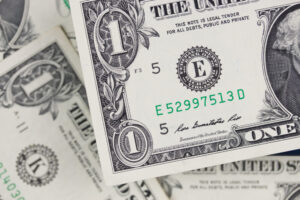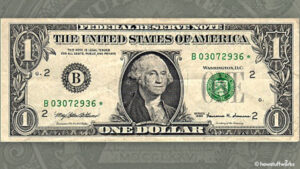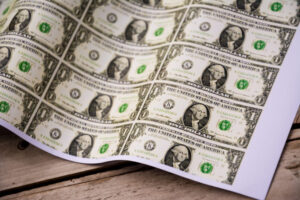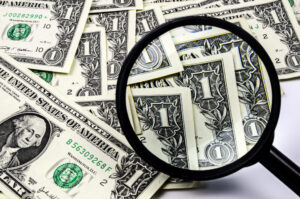People who collect currency are always searching for rare coins and bills. Many things could qualify them as a collectible, such as age, rarity, the material used, or even a mistake in the minting or printing process. But what does it mean if you find a one dollar bill with a star after the serial number? Here’s all you need to know about the Star Note.
What Do the Serial Numbers Mean?

All modern U.S. currency has a serial number specific to the bill. Older notes have 10 digits, and the new style that started circulating in 1996 has 11 digits.
On new bills, the first digit is a letter that signifies the series that the bill comes from. If you look it up, the series will tell you the year of production. The letter changes every time they start a new series. The first letter on older bills, or the second letter on newer ones, indicates which district of the Federal Reserve Bank printed it. The U.S. has 12 districts, and each one is assigned a letter from A – L. The eight numerical digits are the bill’s unique ID number.
On occasion, you may find a bill with a star beside the serial number. Although you won’t find it every day, there are several Star Notes in circulation. And, they exist for every type of bill.
Why Is There a One Dollar Bill with a Star?

A Star Note, or Replacement Note, receives a star next to the serial number as a special designation. If you find a one dollar bill with a star, it was printed to replace the previous bill that was damaged or deemed “imperfect” during the printing process. These could be any printing errors that render them unusable, such as folding, smeared ink, misprints, etc. Based on official estimates, there is approximately one error for every 100,000 bills they print.
The replacement notes allow the Treasury to continue using the set of serial numbers while keeping the correct number of bills in the series. However, Star Notes have their own sequence since it is illegal to print two bills with the same serial number. You can distinguish a Star Note from a regular bill because it will have a small star either in front or at the end of the serial number. When it comes to the one dollar bill, you will find the star following the serial number.
How Much Is a One Dollar Bill with a Star Worth?

A Star Note is rarer than your average dollar bill. But generally speaking, they aren’t worth much more than their face value. The average Star Note sells for around $3. The most valuable one is the 1993 Philadelphia District Star Notes which can bring up to $65. However, if it comes from a rare series or in a full sheet, it could be much more valuable. This guide will give you an idea of the current value for each series and denomination of Star Notes.
Other Considerations When Collecting Bills
Another thing that makes the bill more valuable is if it has an interesting serial number. Some collectors focus on bills with lower serial numbers or groups with consecutively numbered notes. There are also specific numeric patterns that draw more interest as well.
-
- Repeater Note – The numbers on these bills repeat the same pattern within the same serial number (i.e. 12341234.)
- Radar Note – On this type of note, the serial number reads the same forwards and backward (i.e. 12344321.)
- Binary Note – This note has a serial number with the same two randomly repeating digits (i.e. 11221212.)
- Ladder Note – This one has a serial number with six numbers in sequence (i.e. 54123456.)
- Matching Note – On this note, the same number is repeated consecutively in the serial number (i.e. 78222222.)
Bills that contain errors are also more valuable. For example, there was an incident in 2016 where two facilities miscommunicated and used overlapping serial numbers. If you find one of these notes, they can sell for anywhere from $15-$20.
How Can You Sell Your Star Note?

If you were lucky enough to find one, you can look up a Star Note’s serial number here to see how rare it is. If you decide to sell it, you will know how much to ask for it. You can also compare prices and find buyers through auction sites like eBay, Mercari, or Heritage Auctions. If it is in good condition, your Star Note could bring you some extra cash.
But, it’s important to remember that a one dollar bill with a star is only worth what someone is willing to pay. So if you want to get the most bang for your buck, you should seek out coin collectors and currency enthusiasts. At the end of the day, many people decide that the sentimental value is worth much more than the sale price.
Have you ever found a Star Note? Share your comments and pictures below!
Read More
- How To Profit As A Coin Collector
- Most Unusual But Valuable Collections
- 10 Coins In Your Pocket Worth More Than Face Value
Come back to what you love! Dollardig.com is the most reliable cash-back site on the web. Just sign up, click, shop, and get full cashback!
Read the full article here
















